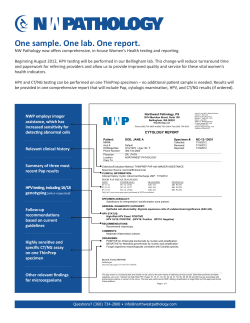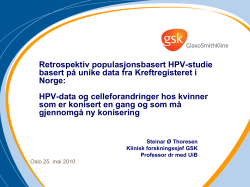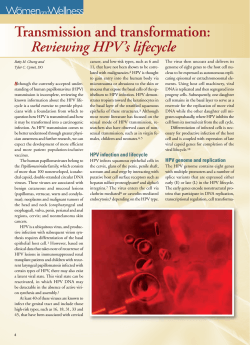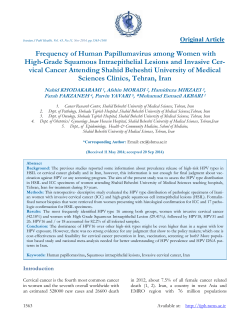
PDF hosted at the Radboud Repository of the Radboud University Nijmegen
PDF hosted at the Radboud Repository of the Radboud University Nijmegen This full text is a publisher's version. For additional information about this publication click this link. http://hdl.handle.net/2066/25323 Please be advised that this information was generated on 2014-10-28 and may be subject to change. Am. J. Trop. Med. Hyg., 57(2), 1997, pp. 138-141 Copyright © 1997 by The American Society of’ Tropical Medicine anti Hygiene A SSO C IA T IO N O F IN FECTIO N S W ITH H U M A N IM M U N O D E F IC IE N C Y V IR U S AND H U M A N PA PILLO M A V IRU S IN H O N D U R A S A N N A B ELLE FERRERA, WILLEM J. G. M ELCHERS, JOHAN P. V E L E M A , a n d M ANUEL FIG U ERO A Departamento de Microbiología, Universidad Nacional Autonoma de Honduras, Tegucigalpa, Honduras; Department of Medical Microbiology, University of Nijmegen, Nijmegen, The Netherlands; Department of Public Health, Erasmus University, Rotterdam, The Netherlands papillomavirus Abstract. cancer has been widely proven. Since this cancer occurs more frequently in immunosuppressed individuals, we sought and fected prostitutes in Tegucigalpa, Honduras. Cervical scrapes were collected from 23 HIV-seropositive and 28 HIVseronegative prostitutes for HPV DNA detection by the polymerase chain reaction. Fifty-six percent of the HIVseropositive women and only 18% of the seronegative women were HPV DNA positive (odds ratio = 6.0). In addition, there was a significant association between seropositivity for HIV with a history of sexually transmitted diseases (P < 0.01). Our data confirm the association between infections with HIV and HPV. ^ _____________ _____ ^ . « * « a « « * ’r ' r T r \ * r* i i * r i r w f « that 49% of the HIV-infected women studied had HPV in fections compared with 25% of a group of non-HIV-infected women. In addition, 40% of the HIV-infected women had SILs on cervical cytology, compared with 9% of the non infected women. Recent reports have also described in creased rates of both HPV and anal dysplasia or neoplasia in HIV-positive men.18 Considering the high prevalence of HIV infection and tak ing into account that carcinoma of the cervix is the most common type of cancer among women in Honduras, it is of utmost importance to the public health interest to gain a better understanding of the association between HIV and HPV with respect to the development of cervical cancer. We are also not aware of any study that has addressed this problem in the Central American region. This investigation was designed to assess the possible association between HPV and HIV among prostitutes with and without HIV in fections in Tegucigalpa, Honduras. Human immunodeficiency virus (HIV) is the causative agent' of the acquired immunodeficiency syndrome (AIDS). Infection with the virus is followed over widely varying periods of time by progressive immunodeficiency and increas ing rates of infectious diseases and neoplasms. Honduras has the highest incidence of AIDS cases in Cen tral America and up to January 1996, a total of 5,008 cases had been recorded, 65.7% males and 34.3% females.1 Fur thermore, the heterosexual spread of HIV in this country has occurred at an alarming rate during the past four years, with the proportion of cumulative AIDS cases attributable to het erosexual contact increasing from 77% of the total number of cases in 1990 to 88% in 1995.1 This is even higher than that observed in the United States, Europe, and other Latin American countries.2 O f particular clinical significance are recent reports that women with HIV have a higher rate of cervical abnormali ties, including human papillomavirus (HPV) infection, ab normal Pap smears, and squamous intraepithelial lesions (SILs).1 5 This recognition of the importance of cervical dis ease in HIV infection has led the Centers for Disease Control and Prevention (Atlanta, GA) to include cervical cancer as an AIDS-delining illness in women.6 Epidemiologic and experimental data support the etiologic role of HPV in the development of cervical cancer.7 0 The oncogenic HPV genotypes (mainly 16 and 18) have been in 80-90% of cervical (CIN) grade 3 lesions and invasive cervical cancers. The prevalence of particular HPV types varies between different geographic regions.10 In addition, CIN associated with gen ital HPV infection occurs with increased frequency and se verity among persons with immunodeficiency” and intragenically immunosuppressed women after kidney transplan tation.12 A number of studies have indicated that the prevalence of HPV infection and HPV-induced epithelial abnormalities is higher in HIV-seropositive women than in HIV-seronegative w om en.13-15 Schrager and others1'’ in their study determined that 31% of HIV-infected women had cytologic squamous atypia, compared with only 4% of HIV-seronegative women. Feingold and others17 extended these observations, present ing molecular evidence of HPV infection in the cervicovaginal epithelium of women with HIV infection. They found t SUBJECTS AND METHODS Study population. Between November 1994 and Pebru ary 1995, and 28 HIV-seronegative Crucitas health care clinic and the clinic of the Nongovernmental Or ganization (NGO) Fight Against AIDS, both located in Te gucigalpa, Honduras were recruited for the study. These women were routinely screened for sexually transmitted dis eases because of their profession and were without any ev idence of gynecologic complaints. Participation in the study was voluntary and all women gave informed consent. The study was approved by the Ethical Commission of the Min istry of Health. The Las Crucitas health care center of the Ministry of Public Health is a clinic for the control of sexually trans mitted diseases where women attending supposedly at w eek ly intervals are routinely diagnosed and treated for syphilis, gonorrhea, and HIV. The NGO is located in the red light district o f Tegucigalpa and was established in 1989 mainly to implement interventions aimed at reducing high-risk b e havior in the HIV epidemic. Furthermore, medical care anti advice is also provided to people already infected with the virus. Bkl 138 139 ASSOCIATION OF HIV AND HPV IN HONDURAS T able 1 T able 2 S e le c te d dem ographic and behavioral characteristics in the study population* A ge N o. A ge A ge (years) o f pregnancies at first pregnancy at first intercourse HIV-seropositive (n = 23) Mean HI V-s ero negative (n « 28) Mean 33 4 16 15 31 3 16 16 * HIV - human immunodeficiency vims. All the women in the study, who defined themselves as prostitutes, were given a physical examination, including a pelvic examination. A vaginal secretion or genital ulcer di rectly visualized was noted. They were interviewed regard ing demographic variables and questions concerning HPVassociated risk factors, sexual history and practices, presence of sexually transmitted diseases, and use of oral contraceplives. A blood sample was obtained from all woman for de tection o f antibodies to HIV. No cytologic analysis was per formed for these women because of logistic and financial problems. Serologic analysis for HIV. Sera were tested for anti bodies to HIV using a commercially available enzymelinked immunoassay (HIVAB-HIV-1 EIA; Abbott Labora tories, North Chicago, IL). Positive and borderline samples were retested and confirmed by Western blot assay (Cam bridge Biotechnology, Worcester, MA). A Western blot was considered positive if two of the following bands were found: p24, gp41, or gp 120/160. Detection of H PV DNA. For the analysis of HPV, cer vical scrapes were taken from the transformation zone of all women with a wooden spatula and the cells were eluted in 5 ml of phosphate-buffered saline (PBS) containing 0.05% ate. ills were vorte leted, and resuspended in 0.5 ml of PBS and stored at - 2 0 C ir vir Extraction of DNA from the thawed cells was performed according to the standard sodium dodecyl sulfate-proteinase as pr K-phenol-c AH samples were prescreened with the (3-globin primers P C 0 3 /P C 0 4 21 to assess sample integrity. A general primermediated polymerase chain reaction PCR (GP-PCR) strategy was then followed for the analysis of the samples for the presence of IIPV DNA.*- Briefly, the overall presence of HPV was assessed using a general primer set (GP5/GP6) directed against the late viral eapsid proteins (LI) open read ing frame, which is highly conserved among all papilloma viruses. This GP-PCR assay detects a broad range of genital HPV types as well as unidentified HPV types (HPV X). A low-stringency Southern blot analysis was performed with a cocktail probe consisting of GP-PCR products specific for HPV 6, 11, 16, 18, 31 and 33.22 To prevent contamination, strict spatial partitioning of the different technical steps of the PCR was done and the recommendations of Kwok and were D ata analysis. Data were analyzed using Epi for Disease Control and Prevention, Atlanta, G by Fisher’s program. Statistical significance was Comparison o f oral contraceptive use, ST D Oral contraceptive STD history U lcers , and ulcers’1' HIV-positive (n = 23) HIV-negative ( h = 28) p 7 19 3 10 9 0 0.77 <0.01 < 0.09 * STD = sexually transmitted disease; HIV - human immunodeficiency virus, exact test. Any P value less than 0.05 was niiicant. The odds ratio (OR) and exact 95% terval (95% Cl) were calculated to measure between HPV and HIV infection. sig - inassociation RES ULTS The general characteristics of the 51 prostitutes concern ing age and selected behavioral variables are summarized in Table 1. The HIV-seropositive and -seronegative women en rolled in this study did not differ significantly from each other for these characteristics. The women were in their ear ly 30s, all had had at least one pregnancy, and had experi enced their first sexual intercourse and first pregnancy before the age of 20. Differences between HIV-positive and HIV-negative pros titutes concerning use of oral contraceptives, history of sex ually transmitted diseases, and presence or absence of ulcers in the genital area were further analyzed. As shown in Table 2, HIV-seropositive women reported more frequently a his tory of sexually transmitted diseases than HIV-negative women (P < 0.01). The presence o f ulcers in the genital area was of a borderline significance (P < 0.09). There was no difference in use of oral contraceptives among HIV-se ropositive and HIV-seronegative women (30% and 35%, reAs seen in Table 3, a total of 18 (35%) of 51 prostitutes tested positive for HPV DNA by PCR: 13 (56.5%) of 23 of the HIV-positive women compared with only 5 (18.0%) of 28 of the HIV-negative women, giving a strong association between detection of I-IPV DNA in cervical scrapes and positivity for antibody to HIV in serum (OR — 6.0, 95% Cl = 1. 5- 26.7). .SCUS” as a high-risk group for all sex ually transmitted diseases, including infections with HPV and HIV. In Honduras, the number o f AIDS cases and the seroprevalence of HIV infection among prostitutes has been increasing. According to Mann and others,2'1 the of HIV infection among female prostitutes in San Pedro Sula, the second largest city in Honduras with the T a b le 3 Prevalence o f human p< HIV- posili ve (n 23) Ur 13 DNA* avirus HIV-negutive <n - 2H) 5 OR *>5% Cl 6.0 1,5-26.7 (18.09 * HIV ~ human immunodeficiency virus; OR - odds ratio; Cl * confidence inter vu!. 140 FERRERA AND OTHERS highest incidence of AIDS cases, has increased from 19% in 1987 to 37% in 1990. The results of our survey indicate that women practicing prostitution and testing positive for antibodies to HIV had a six-fold increased risk for HPV infection as compared with HIV-negative prostitutes. The association between HPV in fection and HIV infection found in this study parallels the results from other countries.14,15 Laga and others,14 in a study among prostitutes in Kinshasa, Zaire, reported a significant association of HPV infection and CIN with HIV seropositivity. Eight (73%) of 11 seropositive women with CIN had HPV detected in that study. Vernon and others,25 in another study among prostitutes also in Kinshasa, Zaire of HPV DNA in HIV-1-seropositive and -seronegative women, showed that detection of HPV DNA in the cervix was highly associated with HIV-1 seropositivity. They estimated a 42.8% prevalence of HPV in HIV-1-seropositive women and 13.4% in seronegative women. In a study of mainly intravenous, hard drug-using, HIVinfected prostitutes in Amsterdam, The Netherlands, van Doomum and others26 demonstrated that in this group HIV infection was associated with a higher prevalence of HPV infection but not with a higher rate of abnormal cervical cytology. These results are comparable with the findings of a study among prostitutes in Nairobi, Kenya, in which 37% of 147 HIV-positive women and 24% of 51 HIV-negative women were found to be positive for cervical HPV DNA.27 Nevertheless, the 1.7-fold increase in the risk of cervical HPV infection associated with HIV infection was not statis tically significant. These investigators indicated that their re sults were caused by the composition of their study popu lation, which included only a small number of women with °ase and by the occurrence of advanced HIV-related HPV-related disease after a long latent period. A recent study among women in Malawi reported that HIV-infected women had twice the risk of abnormal cervical cytology than un infected ones and were more likely to have persistent HPV infections (48% versus 23%).2K In our study, HPV DNA was found in 56.5% of the HIVseropositive prostitutes. A higher prevalence of HPV infec tion in HIV-infected women may be the first step leading to dysplastic lesions. Data from a study by Koutsky and oth ers24 of CIN support the hypothesis that high-grade lesions may develop early in the course of HPV infection. Since the progression to invasive disease is more aggressive in the HIV population, they need closer surveillance at clinics that provide frequent cytologic screening and appropriate coun seling. Although our study sample size was small, it included HIV-negative controls and the women were relatively ho mogeneous in terms of sexual activity and high exposure risk for HIV. In addition, HPV DNA was assayed with a sensitive GP-PCR, which detects a broad spectrum of genital HPVs,22 whereas some previous studies have estimated HPV infection based on cervical cytology.15-I() Cytologic evidence o f HPV infection is highly subjective, with koilicytotic atypia, characterized by the presence of cells with perinuclear cytoplasmic vacuolation, nuclear enlargment, and regarded as the hallmark of HPV infection, being the only patho gnomonic finding. This suggest that PCR-based HPV detec- tion methods could reduce the underestimation of the asso ciation of HPV and HIV infection found in some studies. In conclusion, it may be stated that in this group of HIV-positive and HIV-negative prostitutes the prevalence of cervical HPV DNA was found to be associated with HIV infection. A cknow ledgm ents: W e thank the personnel o f the STD and NGO Clinics for active collaboration. Financial support: This study was supported by grant C I1!|!-CT920003 and C I* C T 9 4 -9 0 1 1 from the C om m ission o f the European Communities. Authors’ addresses: Annabelle Perrera, PO B ox 3 0 078, Tegucigalpa, Honduras. W illem J. G. M elchers, Department o f M edical M icro biology, U niversity Hospital Nijm egen, 6500 HB Nijm egen, The Netherlands. Johan P. Velema, Department o f Public Health, Eras mus University, PO B ox 1738, 3000 DR Rotterdam, The Nether lands. Manuel Figueroa, Departamento de M icrobiología, Universi dad N acional A utonom a de Honduras, Tegucigalpa, Honduras. REFERENCES 1. M inistry o f Health. January 1996. D ivision o f STD s and A ID S, Honduras. 2. World H ealth Organization, 1995. W eekly E pidem iological R e cords, N e w York. 3. Vermund SH , K elley KF, Klein RS, Feingoid AR, Schreiber K, Munk G, Burk RD, 1991. High risk o f human papillom avirus infection and cervical squamous intraepithelial lesions am ong w om en w ith symptomatic human im m unodeficiency virus in fection. A m J O b stet G ynecol 165: 3 9 2 -4 0 0 . 4. Klein RS, H o GYF, Vermund SH, Flem ing I, Burk RD, 1994. Risk factors for squamous intraepithelial lesions on Pap smear in w om en at risk for human im m unodeficiency virus in fec tion. J In fect D is 170: 1 4 0 4 -1 4 0 9 . 5. Centers for D isease Control, 1990. Risk for cervical disease in I-IIV-seropositive wom en, N ew York City. M M W R M o rb M o rta l W kly Rep 39: 8 4 6 -8 4 9 . 6. Centers for D isease Control, 1992. 1993 revised classification system for HIV infection and expanded surveillance case def inition for A ID S among adolescents and adults. M M W R M o rb M o rta l W kly Rep 41: 1-19. 7. M unoz N , B osch FX, de Sajose S, Tafur L, Izargugaza I, Gili M, V iladiu P, Navarro C, Martos C, A scunce N, G onzalez LC, K aldor JM, Guerrero E, Lorincz A, Santamaria M, A lo n so de R u iz P, Aristizabal N, Shah K, 1992. The causal link betw een H PV and invasive cervical cancer: a populationbased case-control study in Colom bia and Spain. Int J C a n c e r 52: 7 4 3 -7 4 9 . 8. Schiffm an MI-I, 1992. Recent progress in defining the ep id e m iology o f human papillomavirus infection and cervical n eo plasia. J N a tl C an cer Inst 84: 3 9 4 -3 9 8 . 9. Kjaer SK , van den Brule AJC, Bock JE, Poll PA, Engholm G, Sherman M E, Walboomers JMM, Meijer CJLM, 1996. H u man papillom avirus- the most significant risk determinant o f cervical intraepithelial neoplasia. Int J C a n ce r 65: 6 0 1 -6 0 6 . 10. M elchers WJG, Claas HCJ, Quint WGV, 1991. Use o f the po l y merase chain reaction to study the relationship betw een hu man papillom avirus infections and cervical cancer. E ur J C/in M i c r o b io l Infect D is 10: 7 1 4 -7 2 7 . 11. Braun L, 1994. R ole o f human im m unodeficiency virus in fe c tion in the pathogenesis o f human papillom avirus-associated cervical neoplasia. Am J Pathol 144: 2 0 9 -2 1 3 . 12. A lloub M I, Barr B B D , McLaren KM, Sm ith IW, Bunney M H, Smart GE, 1989. Human papillomavirus infection and cer vical intraepithelial neoplasia in wom en with renal allografts. B r M e d J 298: 153-156. 13. M andelblatt JS, Fahrs M, Garibaldi D, Senie RT, Person H B, 1992. A ssociation between HIV infection and cervical n e o plasia: im plication for clinical care o f w om en at risk for both conditions. A ID S 6: 173-178. ASSOCIATION OF HIV AND HPV IN HONDURAS 14. Laga M, Icenoglc JP, M arsella R, Munoka AT, Nzila N , Ryder RW, Vermund SH , Heyward W L, N elson A, R eeves WC, 1992. Genital papillom avirus infection and cervical dysplasia. Opportunistic com plications o f HIV infection. Ini J C ancer 50: 4 5 -4 8 . 15. Byrne M A , Taylor-Robinson D, Munday PE, Harris JRW, 1989. The com m on occurrence o f human papillomavirus infection and intraepithelial neoplasia in w om en infected by HIV. A ID S 3: 3 7 9 -3 8 2 . 16. Schräger LK, Friedland GH, M aude D, Schreiber K, Adachi A, Pizzuti DJ, K oss LG, K lein PS, 1989. Cervical and vaginal squamous abnorm alities in wom en infected with human imvirus. J A c q u ir Immune Defic Svndr 2: 5 7 0 -5 7 5 . 17. Feingold A R , Vermund SH, Burk RD, ,‘hrager LK, Schreiber K, Munk G, Friedland GH Klein RS, 1990. Cervital pytologic abnorm alities and pa aviruses in women infected with human im m unodeficiency virus, J A cqu ir Im mune Defic S yn d r 3: 8 9 6 -9 0 3 . 18. Breese PL, Judson FN, Penley KA, D ouglas JM, 1995. Anal human papillom avirus infection among hom osexual and bi sexual men: prevalence o f type-specific infection and associ ation with human im m unodeficiency virus. Sex T m n sm D is 22: 7 - 1 3 . 19. M elehers WJG, Perrera A, W illem se D, Galanía J, Walboomers J, de Barahona O , Figueroa M, Snij tiers P, 1994. Human pap illom avirus and cervical cancer in Honduran wom en. A m J Trap M e d H yg 50: 1 3 7 -1 4 2 . 20. M elehers W JG, van den Brule AJC, Walboomers MM, de Bruin M, Herbrink P, M eijer C.ILM, Lindeman J, Quint W, 1989. Increased detection rate o f human papillomavirus in cervical scrapes by the polym erase chain reaction as compared to modified FISH and Southern-blot analysis. ./ M e d Virol 27: 3 2 9 -3 3 5 . 21. Saiki RK, Scharf S, Faloona F, Mullis KB, Horn GT, Erlich HE, ? 22. 23. 24. 25. r 26. 27. 28. 29. 141 Arnheim N, 1985. Enzymatic amplification o f (3-globin ge nom ic sequences and restriction site analysis for diagnosis of sickle cell anemia. Science 230: 1350- 1354. Snijder PJF, van den Brule AJC, Schrijnemakers HFJ, Snow G, M eijer CJLM, W alboomers JMM, 1990. The use o f general primers in the polym erase chain reaction permits the detection o f a broad spectrum o f human papillomavirus genotypes. J Gen Virol 71: 173-181. Kwok SK, Higuclvi R, 1989. A voiding false positives with PCR. N ature 339: 2 3 7 -2 3 8 . Mann J, Tarantola D, Netter D, 1992. AIDS in the World: A G lo bal Report. Cambridge: Harvard University Press. Vernon SD, Reeves W C, C lancy KA, Laga M , St. Louis M, Gary HE Jr, Ryder RW, Munoka AT, Icenogle JP, 1994. A longitudinal study o f human papillomavirus D N A detection in human im m unodeficiency virus type I-seropositive and -seronegative wom en. J Infect D is 169: 1108-1112. van Doornum GJJ, van den Hoek JAR, van A m eijden EJC, van Haastrecht HJA, Roos M ThL, Henquet CJM,‘ Quint WGV, Coutinho RA, 1993. C ervical H PV infection among HIVinfected prostitutes addicted to hard drugs. J M e d Virol 41: 185-190. Kreiss JK, Kiviat NB, Plummer FA, Roberts PL, Waiyaki P, N gugi E, Holmes KK, 1992. Human im m unodeficiency virus, human papillomavirus, and cervical intraepithelial neoplasia in Nairobi prostitutes. Sex Transm Dix 19: 5 4 -5 9 . Miotti PG, Dallabetta GA, Daniel RW, Canner JK, Chiphangwi JD, Liomba GN, Yang LP, Shah KV, 1996. C ervical abnor m alities, human papillomavirus, and human immunodeficien cy virus infection in w om en in M alawi. J Infect D is ¡73: 7 1 4 -7 1 7 . Koutsky LA, Holmes KK, Critchlow CW, Stevens CE, Paavonen J, Beckmann AM , D eR ouen T A , G allow ay D A , Vernon D, Kiviat NB, 1992. A cohort study o f the risk o f cervical intraepithelial neoplasia grade 2 or 3 in relation to papillo mavirus infection. N Engl J M e d 327: 1 2 7 2 -1 2 7 8 . t
© Copyright 2025










